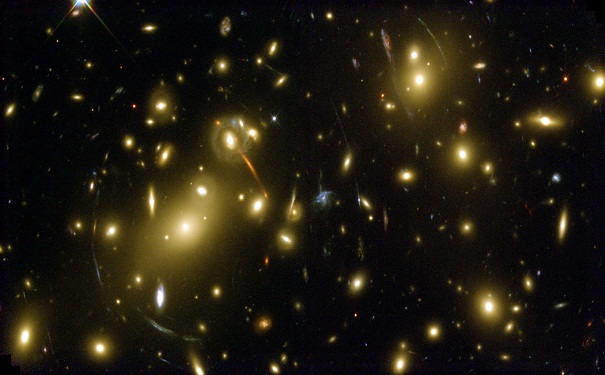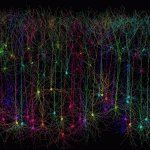
A Brightest Cluster Galaxy (BCG) appears as the orange arc in galaxy cluster Abell 2218 when captured by the Hubble Space Telescope. Credit: NASA, Andrew Fruchter and the ERO Team-Sylvia Baggett (STScI), Richard Hook (ST-ECF), Zoltan Levay (STScI).
New data reveals that the Universe’s biggest galaxies should have tripled in size.
Large galaxies are believed to form as the result of gravitational attraction and the subsequent merging of smaller sub-galaxies. But new data from Liverpool John Moores University (UK) has suggested that some of the largest objects in the Universe stopped growing seven billion years ago.
The scientists examined the largest galaxies in the Universe, known as Brightest Cluster Galaxies (BCGs), which usually have a mass equivalent of up to ten trillion Suns. The nearest BCGs are elliptical in shape and are thought to have formed from the merger of the smaller sub-galaxies found at the centre of galaxy clusters.
Measuring BCGs has always been a challenge, due to their faint outer regions. PhD student Claire Burke and her team overcame this by using data from the Hubble Space Telescope to make long exposure (over 10,000 seconds) images, enabling them to pick up the dimmer regions of the galaxies.
The light coming from the BCGs in question is seven billion years old, so the scientists were able to see the galaxies as they would have been seven billion years ago. They found that the BCGs were almost the same size as their nearby counterparts, which have grown by 30 per cent over the last 9 million years.
According to the conventional simulations of the evolution of the Universe, the BCGs should have at least tripled in size over that time. Instead, they seem to have stopped growing when the Universe reached half its present age.
Studying how the BCGs grow will give scientists an insight into how other galaxies grow and evolve. Professor C. Burke said in the press release “The lack of growth of the most massive galaxies is a major challenge to current models of the formation and evolution of large scale structure in the Universe.
“Our work suggests that cosmologists appear to lack some of the crucial ingredients they need to understand how galaxies evolved from the distant past to the present day.”






